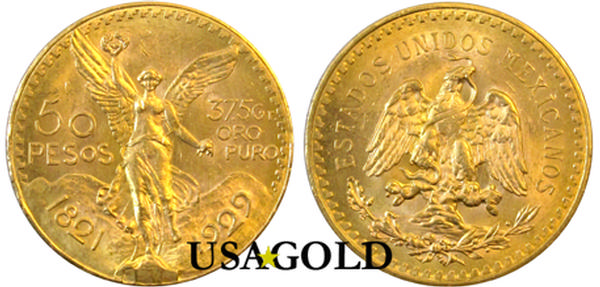
Grade range: Uncirculated/Brilliant Uncirculated
Minted: 1921 to 1931
(Pre-1933 mintages only; no restrikes)
Actual Gold Content: 1.2057 troy ounce
Questions? Give us a call or send us an email. Market insight, analysis & guidance from real experts with real experience. 46 years in business. A+ BBB. Zero complaints.
Less than 1/10 as many Mexico 50 pesos were struck as US $20 St. Gaudens during the 1920s alone. If you include the total mintage of $20 gold pieces across their 80 year production, the total population of Mexico 50 pesos is a mere 3% that of the $20 gold pieces. With premiums on uncirculated $20 gold pieces at times topping 50%, the opportunity for long-term premium growth in the Mexican 50 Pesos coins is notable. From 1921 to 1931, over 4.9 million 50 pesos were struck compared to nearly 50 million $20 St. Gaudens.*
Historical Note:
The 20th century is rife with examples of financial breakdown and Mexico’s rendezvous with economic disaster in 1994 is among the most instructive. The crisis began, as happens so often in these affairs, with a surprise announcement by Mexico’s government that the currency had been devalued. As soon as it was made public, depositors lined up at the banks to retrieve their money and inundated brokerages with sell orders. A general panic gripped the nation almost immediately. The inflation rate went to 50% overnight, and interest rates soared to 70%.
Only a proper diversification into gold well before the crisis emerged properly insulated savers from the devaluation’s pervasive reach into every area of the financial system. In many cases, those who managed to diversify did so in the physical gold former-coinage of the country. Immediately after the devaluation, the price of gold went from 1200 pesos per ounce to 2500 pesos, and from there it exceeded 3000 pesos in 1995, living up to its reputation as a safe-haven for investors.
In 1910 Mexico celebrated the Centennial of the beginning of its War of Independence with Spain. To commemorate the event, a giant column was erected in the middle of Mexico City with a statue of El Angel de la Independencia (The Angel of Independence), sitting atop. This 6.7-meter statue, constructed of Bronze and Gold, represents the “Winged Victory,” a Greek symbol for the goddess Nike (Victory). In her right hand the Angel holds a laurel crown, symbolizing Victory, while in her left she holds a broken chain, symbolizing Freedom.
*As a final note of clarification, the information above does not include re-strike versions of both the 50 pesos and 20 pesos. Both coins were heavily re-struck from 1944-1975, typically carrying the date 1947 in the case of the 50 pesos, and 1959 in the case of the 20 pesos. These re-strike coins are bullion items that carry lttle to no premium potential.


